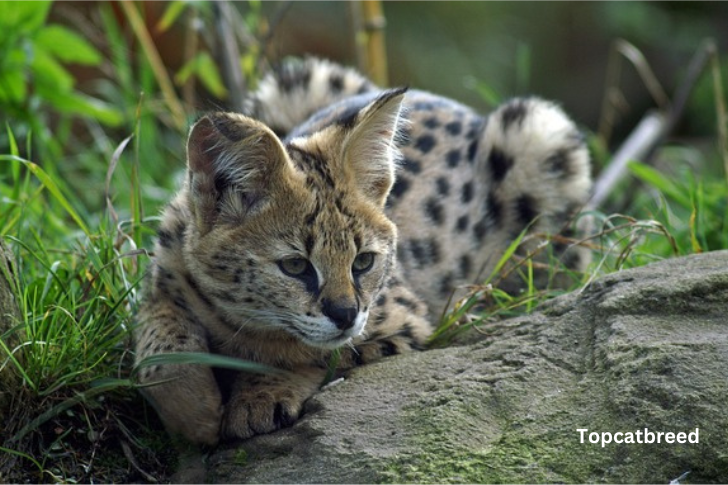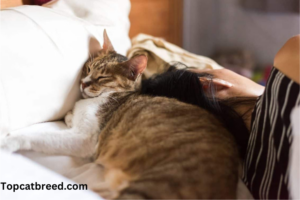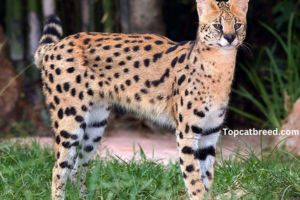Ever wondered, “Can a serval cat kill a human?” The straightforward answer: no. Despite their wild nature and remarkable attributes, serval cats are quite unlikely to endanger humans. Originating from sub-Saharan Africa, these feline wonders boast agility and sharp claws for survival. Documented cases of serval attacks on humans are exceptionally rare. While the possibility of a serval cat attacking a human is remote, it is critical to be prepared. Remember to keep calm in such an extraordinary occasion. Protect your face and neck, as a serval may target these regions during an attack.
In the wild, servals, with their distinctive appearance and adept hunting skills, prefer maintaining a safe distance from human activity. Even in captivity, where behavior may be influenced by socialization, the chances of harm remain minimal. Understanding these creatures and promoting responsible interaction ensures a peaceful coexistence between us and these fascinating wild cats. In this article we gave you all details about Can a serval cat kill a human.
How powerful is a Serval’s Bite?
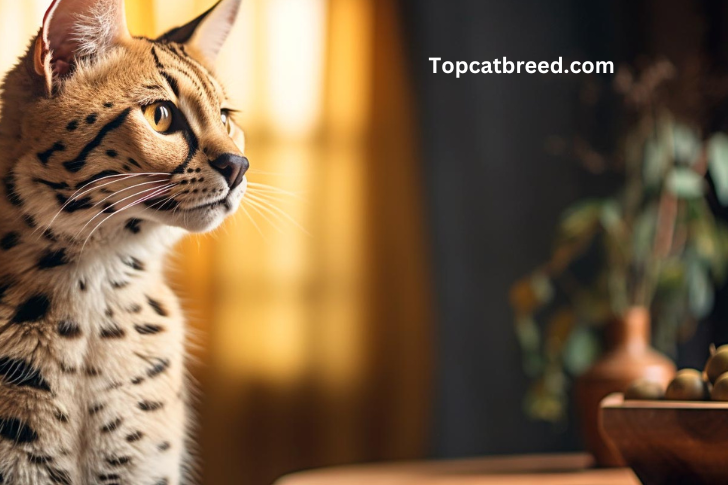
Curiosity about a servals bite is natural, considering their wild prowess. Serval cats, native to Africa, boast a jaw strength that sets them apart. Their bites, while not the strongest in the animal kingdom, carry a formidable force, ranging from 50 to 100 pounds per square inch (PSI). To put this in perspective, human bites typically fall between 80 to 120 PSI.
While servals are generally shy around humans, it’s wise to exercise caution. In close proximity, it’s best to give them space and avoid provoking any defensive instincts. Understanding the dynamics of a serval’s bite is key to fostering responsible behavior around these captivating creatures. Despite their generally reserved nature, it’s crucial to provide them space and avoid actions that might trigger defensive responses. Although their bites may not match some other species, the potential for injury underscores the significance of respectful coexistence.
What Should You Do If a Serval Cat Attacks You?
In the rare scenario of a serval cat attack, a composed response becomes paramount. Prioritize shielding your face and neck, areas susceptible to their bites. Gradually create distance without sudden movements, utilizing available barriers for protection. Here are key points to remember:
- Prioritize Face and Neck Protection: Shield vulnerable areas, such as your face and neck, which may be targeted during an attack.
- Avoid Sudden Movements: Gradually create distance without sudden movements to reduce the risk of escalation.
- Utilize Available Barriers: Use any available barrier for protection, such as objects or structures that can create distance.
- Refrain from Touching: In the event of an attack, resist the urge to touch or approach the serval, allowing it to recalibrate.
- Observe from a Safe Distance: Step back and observe from a safe distance to minimize the potential for further aggression.
While serval attacks are rare, adopting these measures ensures not only your safety but also contributes to the well-being of these captivating wild cats. This knowledge promotes a harmonious coexistence, fostering understanding and minimizing risks in the rare instances of aggression.
ALSO READ .Can a serval cat kill a dog? _All Details
Physical Characteristics and Capabilities of serval cat
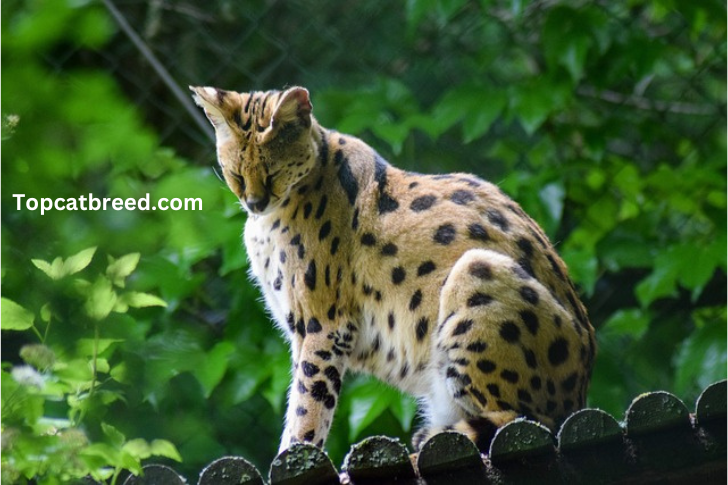
Let’s talk about serval cats! They come from Africa and are not too big, but they’re super cool. Picture this: long legs, a slim body, and big, round ears that make them look unique and charming.
Now, let’s talk about their physical features. Servals have sharp claws that they can retract, like built-in tools for catching and securing prey in the wild. With their impressive agility and powerful hind legs, they navigate their natural habitat with ease. These cats are like the acrobats of nature, moving effortlessly to survive.
Their unique capabilities extend to their acute sense of hearing, helping them skillfully detect the smallest movements of their prey. When it’s time to strike, servals unleash a combination of agility and powerful leaps to capture their meals swiftly. This dynamic blend of physical traits and capabilities defines servals’ special place in the animal kingdom, showcasing adaptations that contribute to their survival in the vast landscapes of sub-Saharan Africa. So, from their distinct appearance to their cool moves, servals have it all – the perfect mix of charm and prowess in the wild.
Are Serval Cats Good Family Pets?
Okay, so servals are awesome in the wild, but are they good for families? Well, not really. You see, servals have special needs, and they’re not like regular pets. They’re shy and might not enjoy the noise of a busy home. Plus, they’re chatty, and not everyone likes a talkative pet.
Now, let’s talk about their chatty nature. Servals can be quite vocal, and not everyone is a fan of a talkative pet. Their distinctive calls and sounds might not be the melody everyone wants in their home.
So, if you’re dreaming of a cozy family pet, a serval might not be the perfect match. But here’s the silver lining: you can still enjoy their beauty and uniqueness from a distance. By appreciating them in their natural habitat, you contribute to their well-being and help maintain the balance of their African homes. It’s like having wild neighbors – you get to admire them, and everyone stays content in their own space!
Managing the Interaction between Serval Cats and Humans
Navigating the interaction between humans and serval cats involves understanding their wild instincts and ensuring a respectful coexistence. Serval cats, originating from sub-Saharan Africa, naturally keep a safe distance from human activities. In the wild, they exhibit a natural wariness of humans, preferring to avoid direct encounters.
When managing interactions, it’s crucial to adopt a cautious approach. Observing servals from a distance is the key to ensuring both human safety and the well-being of these remarkable creatures. Resist the urge to touch or approach them, allowing them to maintain their natural behaviors undisturbed.
In captivity, where their exposure to humans differs, interactions may vary. However, the principles of observation and respect should remain. Even in a captive setting, it’s advisable to let servals express their instincts without undue interference, fostering a sense of security for both parties involved.
Essential Safety Measures and Practices for Responsible Serval Cat Ownership
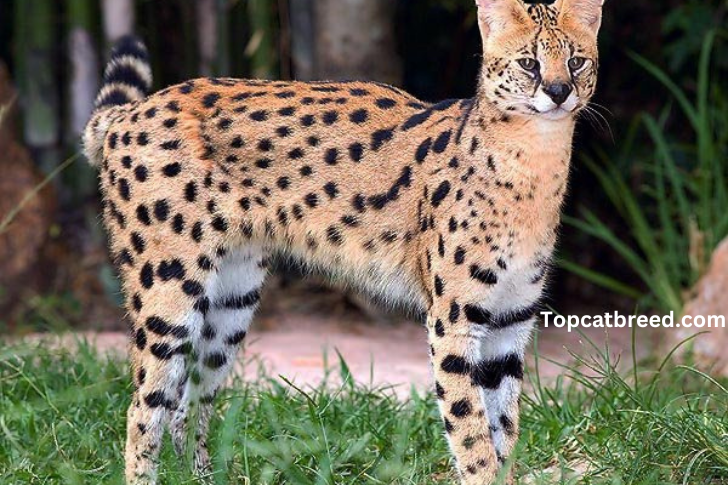
Owning a serval cat is a unique responsibility that demands attention to safety and well-being. Here are six essential safety measures for responsible serval cat ownership:
Observation and Caution: Always observe servals from a safe distance, minimizing direct contact to prevent any unexpected reactions.
Avoiding Provocation: Refrain from actions that might provoke defensive behaviors, as servals can be unpredictable.
Understanding Natural Behavior: Familiarize yourself with servals’ natural behaviors and instincts, allowing them to express themselves without interference.
Seek Professional Guidance: Consult with professionals experienced in serval care to ensure proper understanding of their needs.
Secure Enclosures: If kept in captivity, provide secure enclosures resembling their natural habitat to ensure safety and well-being.
Regular Veterinary Care: Schedule regular check-ups with a qualified veterinarian specializing in exotic cats to monitor health and address any concerns promptly.
By following these safety measures and practices, serval cat ownership can be a rewarding experience. Understanding their behaviors, respecting their space, and prioritizing their welfare contribute to a positive relationship between humans and these captivating wild cats. These are all information about Can a serval cat kill a human
FAQS
Do serval cats attack people?
No, serval cats are not known to be aggressive towards humans. They usually avoid direct encounters and maintain a safe distance.
Do serval cats eat meat?
Yes, serval cats are carnivores and primarily feed on meat. Their diet in the wild consists of small animals like rodents, birds, and reptiles.
What is the kill rate of the serval cat?
The kill rate of serval cats varies, but their hunting success is relatively high due to their agility and keen senses.
Can serval cats be kept as pets?
Keeping serval cats as pets is not recommended due to their unique needs, natural instincts, and challenges in providing proper care.
Are serval cats commonly kept as pets?
No, serval cats are not commonly kept as pets. Strict regulations exist in many countries due to the risks they pose to humans and themselves.
Conclusion
In conclusion, serval cats, with their remarkable physical characteristics and hunting abilities, are not typically aggressive towards humans. While they are not suitable as common pets due to their unique needs, responsible ownership and conservation efforts play a vital role in ensuring the well-being of these captivating creatures. Can a serval cat kill a human By fostering understanding, respecting their space, and prioritizing safety, humans can coexist harmoniously with serval cats, appreciating their role in the wild and supporting conservation initiatives for their continued thriving existence..

